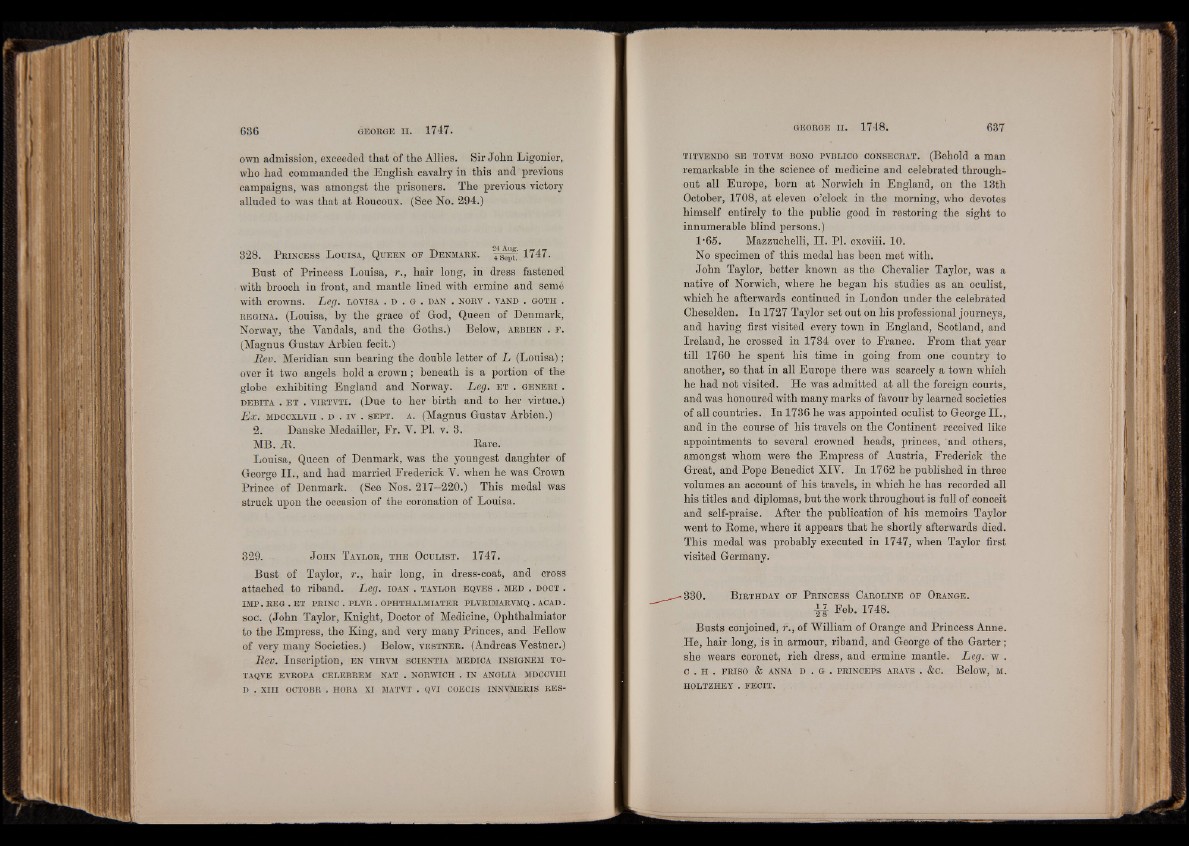
own admission, exceeded that of the Allies. Sir John Ligonier,
who had commanded the English cavalry in this and previous
campaigns, was amongst the prisoners. The previous victory
alluded to was that at Boucoux. (See No. 294.)
328. P r in c e s s L o u isa , Q u e e n o f D enm a r k , 1747.
Bust of Princess Louisa, r., hair long, in dress fastened
with hrooch in front, and mantle lined with ermine and semé
with crowns. Leg. lo v isa . d . g . dan . n o rv . vand . g o th .
r e g in a . (Louisa, by the grace of God, Queen of Denmark,
Norway, the Vandals, and the Goths.) Below, a r b ie n . f .
(Magnus Gustav Arbien fecit.)
Rev. Meridian sun bearing the double letter of L (Louisa) ;
over it two angels hold a crown ; beneath is a portion of the
globe exhibiting England and Norway. Leg. e t . g e n e r i .
d é b it a . e t . viRTVTi. (Due to her birth and to her virtue.)
Ex. m d c c x lv ii . d . iv . s e p t . a . (Magnus Gustav Arbien.)
2. Danske Medailler, Fr. V. Pl. v. 3.
MB. Æ,. Bare.
Louisa, Queen of Denmark, was the youngest daughter of
George H i, and had married Frederick V. when he was Grown
Prince of Denmark. (See Nos. 217-220.) This medal was
struck upon the occasion of the coronation of Louisa.
329. J o h n T a y lo r , t h e O c u l is t . 1747.
Bust of Taylor, r., hair long, in dress-coat, and cross
attached to riband. Leg. io a n . ta y lor eq v e s . m ed . doct .
IMP. REG . ET PRINC . PLVR . OPHTHALMIATER PLVRIMARVMQ . ACAD .
soc. (John Taylor, Knight, Doctor of Medicine, Ophthalmiator
to the Empress, the King, and very many Princes, and Fellow
of very many Societies.) Below, v e s t n e r . (Andreas Vestner.)
Rev. Inscription, e n v irvm s c ie n t ia m ed ic a in s ig n em to -
TAQVE EVROPA CELEBREM NAT . NORWICH . IN ANGLIA MDCCVIII
D . XIII OCTOBR . HORA XI MATVT . QVI COECIS INNVMERIS RESt
it v e n d o s e totvm bono pv b l ic o c o n s ec r a t . (Behold a man
remarkable in the science of medicine and celebrated throughout
all Europe, born at Norwich in England, on the 13th
October, 1708, at eleven o’clock in the morning, who devotes
himself entirely to the public good in restoring the sight to
innumerable blind persons.)
1-65. Mazzuchelli, II. PI. cxcviii. 10.
No specimen of this medal has been met with.
John Taylor, better known as the Chevalier Taylor, was a
native of Norwich, where he began his studies as an oculist,
which he afterwards continued in London under the celebrated
Cheselden. In 1727 Taylor set out on his professional journeys,
and having first visited every town in England, Scotland, and
Ireland, he crossed in 1734 over to France. From that year
till 1760 he spent his time in going from one country to
another, so that in all Europe there was scarcely a town which
he had not visited. He was admitted at all the foreign courts,
and was honoured with many marks of favour by learned societies
of all countries. In 1736 he was appointed oculist to George II.,
and in the course of his travels on the Continent received like
appointments to several crowned heads, princes, and others,
amongst whom were the Empress of Austria, Frederick the
Great, and Pope Benedict XIV. In 1762 he published in three
volumes an account of his travels, in which he has recorded all
his titles and diplomas, hut the work throughout is full of conceit
and self-praise. After the publication of his memoirs Taylor
went to Borne, where it appears that he shortly afterwards died.
This medal was probably executed in 1747, when Taylor first
visited Germany.
330. B ir t h d a y o f P r in c e s s C a r o l in e o f Or a n g e .
L f Feb. 1748.
Busts conjoined, f., of William of Orange and Princess Anne.
He, hair long, is in armour, riband, and George of the Garter;
she wears coronet, rich dress, and ermine mantle. Leg. w .
C . H . FRISO & ANNA D . G . PRINCEPS ARAVS . &C. Below, M.
HOLTZHEY . FECIT.